#Anglo-Saxon Swords
Explore tagged Tumblr posts
Text




Langeid Viking Sword – Windlass
The Windlass Steelcrafts Langeid belongs to its MasterCraft Collection of higher quality swords which have elevated detailing and scabbards. The well-tempered blade is crafted from 1080 high carbon steel which has been sharpened. The guard and pommel to replicate the original Viking sword are of iron which is plated in silver and completed with real copper and gold. The grip is wood is bound in intricately braided silver wire. The sword comes with a wood core scabbard which is bound in etched leather and completed with an integrated sword belt and silver plated fittings.
When a new road was being constructed in Langeid in southern Norway’s Setesdal valley in 2011, workers discovered an ancient Viking burial ground. Along with coins and a broadaxe, an archaeological team exhumed a startling, unique sword that hadn’t seen the light of day for over 10 centuries. Thousands of Viking era swords, in various states of completeness, have been discovered in Norway, but not one of them has an elaborately inscribed hilt like the one exhibited by the weapon they found that day.
Whether the sword originated in Norway or is possibly an Anglo-Saxon weapon that was acquired elsewhere is a matter of conjecture, but there’s no doubt this was an expensive example of deadly artistry that was highly prized by the Viking warrior who owned it. The pommel and downsloping guard are emblazoned with gold and copper, displaying a mixture of Latin characters, Christian and runic symbols whose exact meanings are lost to time, with some characters apparently reversed for the sake of symmetry.
The Latin letters are among the hardest to interpret but may be meaningful abbreviations for Christian messages. They could be anything from Bible verses to worship of Christ in Greek or Latin, somewhat equivalent to Christograms. A cross or “X” may represent Xristos (Christ). “R” occurs in several places and may stand for Rex (king). “H” appears once, and its meaning is rather uncertain. The “E” sign is depicted in various orientations, but its meaning is also mysterious. One character that appears to be a rune might be a stylized “S”. The top of the pommel in portrays a hand holding a cross, possibly representing the hand of Jesus or God. The cross in the hand combined with the “S” sign may, if interpreted loosely, be read as Xristos Salvator (Christ the Saviour), but would then represent a mixture of Greek and Latin.
Interestingly, the grip of this sword is one of the shortest known, only a hair over 3-1/2″. Short grips are very common among Viking swords that have severely down-sloped guards like this one. The owner had either to rest his pinky on the pommel or possibly let his index finger and thumb embrace the guard (as an aside, Viking warriors were known for letting the pommel slide into their palms during a swing to extend the effectiveness of a blow).
This faithful replica is a fully functioning sword with a carbon steel blade that’s battle capable like the original. The pommel and guard are made of iron and silver-plated like the original, and the markings are emblazoned in real gold and copper. We’ve widened the grip slightly for the sake of comfort, but the wire-wrapping is twisted in the same patterns that a prominent Viking hand wielded centuries ago.
The original scabbard had long since deteriorated, so we created one of high-quality leather and laser-engraved it with a pattern created from the pommel imagery. The scabbard comes with its own belt.
#Kult of Athena#KultOfAthena#New Item Wednesday#Windlass Steelcrafts#Langeid Viking Sword#sword#swords#weapon#weapons#blade#blades#MasterCraft Collection#Viking Swords#Viking Weapons#Dark Age Swords#Dark Age Weapons#Norse Swords#Norse Weapons#Anglo-Saxon Swords#Anglo-Saxon Weapons#European Swords#European Weapons#1080 High Carbon Steel#Battle Ready
3 notes
·
View notes
Text
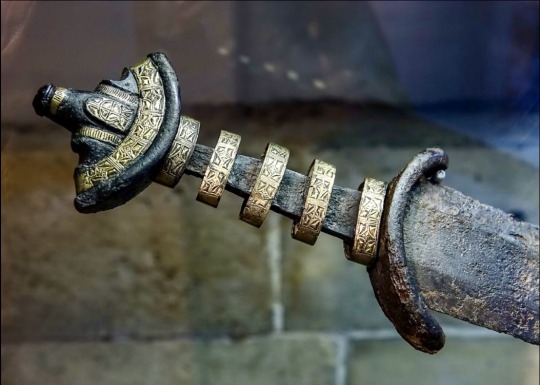
Gilling Sword, Anglo-Saxon sword dating from the late 9th to early 10th centuries AD.
539 notes
·
View notes
Text

#albert kretschmer#art#costumes#items#middle ages#medieval#armour#weapons#charlemagne#franks#frankish#anglo saxon#crown#throne#sword#hand of justice#crown of charlemagne#cups#swords#shield#sceptre#christian#byzantine#banner#throne of charles the bald#sword of childeric#carl rohrbach#instruments#bow#battle axe
122 notes
·
View notes
Text



Silver And Iron Anglian Sword Pommel, 600 to 800 CE, The Yorkshire Museum, York
This silver and iron handle once belonged to a strong and deadly blade. It was probably owned by a powerful earl in the service of a Northumbrian king.
#sword#sword pommel#pommel#archaeology#metalwork#metalworking#swordwork#weapons#ancient living#ancient design#relic#York#Yorkshire Museum#anglo saxon#Anglian
75 notes
·
View notes
Text
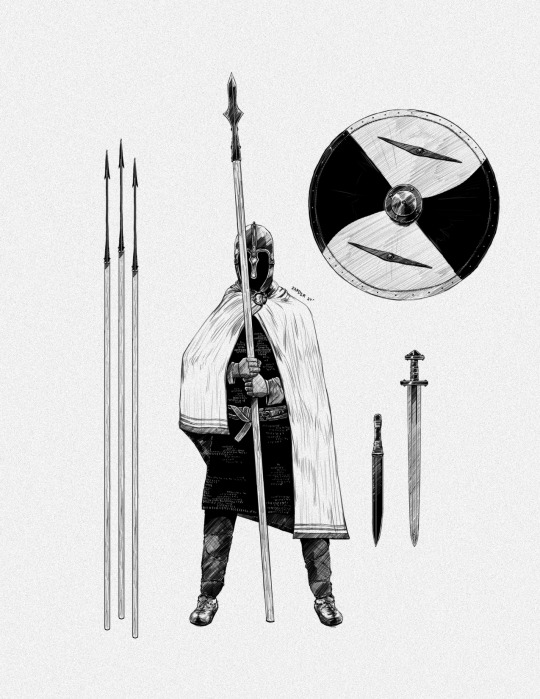
An Anglo-Saxon Warrior - Thane/Thegn
#art#illustration#design#digital art#drawing#drawdrawdraw#character design#sword#rpg#dnd#historical#history#anglo saxon#saxon#england#english#warrior#shield#spear#angon#seax#helmet#cloak
18 notes
·
View notes
Text

“A Saxon storm.”
25 notes
·
View notes
Text

“The huntsman discovers a luscious prize in the antechamber’s cell of the evil palace of Zoqqwad. T is none other than the Princess Raheena of Hyperborea—the huntsman recognises for no other bears such tindered locks and alluring phrenology…and certes, no other bosom which sways and swacks so heavily against golden breastplates.”
#sword and sorcery#fantasy art#princess#damsel#Tarzan#anglo-saxon#celtic#hyperborea#luscious prize for those who explore and conquer evil
11 notes
·
View notes
Photo

Blades of May #12: A ring-sword, found in Buckland . There's no universal scholarly agreement on the purpose of the rings - mostly they're believed to symbolize oaths - but one theory that I think is interesting (if unlikely) is that they were what was used to secure swords to scabbards during meetings between rivals, similar to how costume weaponry is secured at comic cons today.
56 notes
·
View notes
Text
The Heroic age pt3, Blood on the grass
so, part 3! the finale! unfortunately i have little to no more history to actually impart here, and am somewhat debating the wisdom of starting this series but anyways its too late now!
so, our warriors are magnificently clad in steel, gold, silver and garnets, with swords raised to shine like silver fire in the sun and its important to note at this point that most of the battles that took place were very small scale, perhaps only involving 200 men at most in usual circumstances so much of these battles come down to individual valour much more than massed infantry tactics or even any tactical finesse. of course controlling chokepoints and advantageous positions would still be the priority, but the emphasis was very much on the individual, and not on his (or her) fellows.
as modern people we can of course never know how these warriors felt, but one could imagine it lead to a priority on skill for these people. of course skill has always been ideal but in later periods replacing an individual was often more important than making them the best they could be. so these warriors would have likely been, to all intents and purposes irreplaceable, much like their weapons. these people were forged into hardened killers, but also men and women of honour and valour by the time they lived along with their swords, and were as beautiful and deadly as their arms.
thank you all for reading
im not quite as pleased with this series as i was with my series on the longsword, and would honestly appreciate some feedback from you, my readers, in what you want to hear about next? if not i'm sure ill think of something!
goodnight my beloved audience, may your edges stay sharp and your points true! but more importantly, appreciate how your world has forged you. remember; blades are tools and weapons and are neither good nor bad inherently, but are each suited for a specific purpose; you need only look at their shape to divine it, the same may be true of you!
#ancient rome#swords#academia#lord of the rings#sword#adventure#fencing#sword fighting#warrior#viking#armor#anglo saxon
3 notes
·
View notes
Text
Y'all know my husband. 😏
I literally think about this at least every other week.
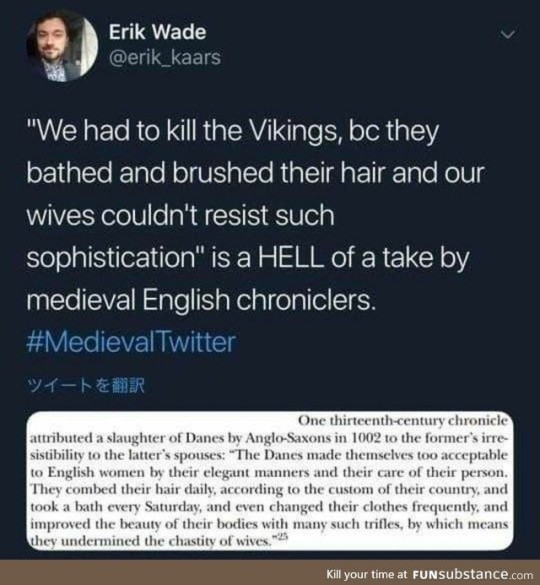
#listen speaking as someone who had a tall muscly blond with a well-groomed beard & good manners & a sword sweep her off her feet....I GET IT#@ anglo-saxon farmers - lol get good scrubs
64K notes
·
View notes
Text



Some panels from a comic I've been working on for a while.
Saxons fighting Vikings and stuff.
#comic#illustration#digital art#anglo saxon#viking#norse#early medieval#longships#sword age#skeggold skalmold#vindold vargold
1 note
·
View note
Text

0 notes
Text
So here's one of the coolest things that has happened to me as a Tolkien nut and an amateur medievalist. It's also impacted my view of the way Tolkien writes women. Here's Carl Stephenson in MEDIEVAL FEUDALISM, explaining the roots of the ceremony of knighthood: "In the second century after Christ the Roman historian Tacitus wrote an essay which he called Germania, and which has remained justly famous. He declares that the Germans, though divided into numerous tribes, constitute a single people characterised by common traits and a common mode of life. The typical German is a warrior. [...] Except when armed, they perform no business, either private or public. But it is not their custom that any one should assume arms without the formal approval of the tribe. Before the assembly the youth receives a shield and spear from his father, some other relative, or one of the chief men, and this gift corresponds to the toga virilis among the Romans--making him a citizen rather than a member of a household" (pp 2-3). Got it?
Remember how Tolkien was a medievalist who based his Rohirrim on Anglo-Saxon England, which came from those Germanic tribes Tacitus was talking about? Stephenson argues that the customs described by Tacitus continued into the early middle ages eventually giving rise to the medieval feudal system. One of these customs was the gift of arms, which transformed into the ceremony of knighthood: "Tacitus, it will be remembered, describes the ancient German custom by which a youth was presented with a shield and a spear to mark his attainment of man's estate. What seems to the be same ceremony reappears under the Carolingians. In 791, we are told, Charlemagne caused Prince Louis to be girded with a sword in celebration of his adolescence; and forty-seven years later Louis in turn decorated his fifteen-year-old son Charles "with the arms of manhood, i.e., a sword." Here, obviously, we may see the origin of the later adoubement, which long remained a formal investiture with arms, or with some one of them as a symbol. Thus the Bayeux Tapestry represents the knighting of Earl Harold by William of Normandy under the legend: Hic Willelmus dedit Haroldo arma (Here William gave arms to Harold). [...] Scores of other examples are to be found in the French chronicles and chansons de geste, which, despite much variation of detail, agree on the essentials. And whatever the derivation of the words, the English expression "dubbing to knighthood" must have been closely related to the French adoubement" (pp 47-48.)
In its simplest form, according to Stephenson, the ceremony of knighthood included "at most the presentation of a sword, a few words of admonition, and the accolade." OK. So what does this have to do with Tolkien and his women? AHAHAHAHA I AM SO GLAD YOU ASKED. First of all, let's agree that Tolkien, a medievalist, undoubtedly was aware of all the above. Second, turn with me in your copy of The Lord of the Rings to chapter 6 of The Two Towers, "The King of the Golden Hall", when Theoden and his councillors agree that Eowyn should lead the people while the men are away at war. (This, of course, was something that medieval noblewomen regularly did: one small example is an 1178 letter from a Hospitaller knight serving in the Latin kingdom of Jerusalem which records that before marching out to the battle of Montgisard, "We put the defence of the Tower of David and the whole city in the hands of our women".) But in The Lord of the Rings, there's a little ceremony.
"'Let her be as lord to the Eorlingas, while we are gone.' 'It shall be so,' said Theoden. 'Let the heralds announce to the folk that the Lady Eowyn will lead them!' Then the king sat upon a seat before his doors and Eowyn knelt before him and received from him a sword and a fair corselet."
I YELLED when I realised what I was reading right there. You see, the king doesn't just have the heralds announce that Eowyn is in charge. He gives her weapons.
Theoden makes Eowyn a knight of the Riddermark.
Not only that, but I think this is a huge deal for several reasons. That is, Tolkien knew what he was doing here.
From my reading in medieval history, I'm aware of women choosing to fight and bear arms, as well as becoming military leaders while the men are away at some war or as prisoners. What I haven't seen is women actually receiving knighthood. Anyone could fight as a knight if they could afford the (very pricy) horse and armour, and anyone could lead a nation as long as they were accepted by the leaders. But you just don't see women getting knighted like this.
Tolkien therefore chose to write a medieval-coded society, Rohan, where women arguably had greater equality with men than they did in actual medieval societies.
I think that should tell us something about who Tolkien was as a person and how he viewed women - perhaps he didn't write them with equal parity to men (there are undeniably more prominent male characters in The Lord of the Rings and The Hobbit, at least, than female) but compared to the medieval societies that were his life's work, and arguably even compared to the society he lived in, he was remarkably egalitarian.
I think it should also tell us something about the craft of writing fantasy.
No, you don't have to include gut wrenching misogyny and violence against women in order to write "realistic" medieval-inspired fantasy.
Tolkien's fantasy worlds are DEEPLY informed by medieval history to an extent most laypeople will never fully appreciate. The attitudes, the language, the ABSOLUTELY FLAWLESS use of medieval military tactics...heck, even just the way that people travel long distances on foot...all of it is brilliantly medieval.
The fact that Theoden bestows arms on Eowyn is just one tiny detail that is deeply rooted in medieval history. Even though he's giving those arms to a woman in a fantasy land full of elves and hobbits and wizards, it's still a wonderfully historically accurate detail.
Of course, I've ranted before about how misogyny and sexism wasn't actually as bad in medieval times as a lot of people today think. But from the way SOME fantasy authors talk, you'd think that historical accuracy will disappear in a puff of smoke if every woman in the dragon-infested fantasy land isn't being traumatised on the regular.
Tolkien did better. Be like Tolkien.
#tolkien#middle earth#jrr tolkien#lord of the rings#lotr#the lord of the rings#eowyn#writing fantasy#fantasy#female characters#writing#historical fiction#medieval women#medieval history#medieval#history#womens history
9K notes
·
View notes
Text
So an interesting thing about Latin is that the word for "sword" is "gladius" and the word for "scabbard" is "vagina".
But here's the weird thing: in classical times, "gladius" was used as a slang word for "penis", but "vagina" was not used as a slang word for "vagina"!
The weird thing is that their term for the "vagina" was "vulva". Now... I'm not being lazy here and meaning the internal and external genitals as "vagina": when they said "vulva", they only meant the internal genitals. They even called the womb "vulva".
Anyways. For the external genitals, what we now would say "vulva" for, they'd use... "cunnus", probably? That's a vulgar word, I'm not even sure what you'd use if you weren't trying to be derogatory.
Although it's amusing to find out that "cunnus" isn't related to "cunt" or "cunny" at all. "cunt" comes from Proto-Germanic (where it meant the same, just not vulgar), and "cunny" goes back to a different Proto-Germanic word that meant "to know".
Anyway the worst Latin-dervived term for female genitalia is "pudendum/pudenda", because it was directly taken from medieval (I believe?) Latin where it meant the same, but if you know latin you can also translate it to which it means: "that whereof one ought to feel shame". Yeah, it's off the verb "pudeō/pudēro": "to shame". Fucking yikes.
And along those lines, reportedly a roman slang term for the female genitalia was "culpa", which means a fault or defect. Yikes again.
The final bit of weirdness is that "genitalia" is also a Latin word: but it doesn't mean the genitals, not specifically. It's instead a neutral plural for an adjective that means "related to birth or production".
So yeah. It's weird that English has so many Latin roots and then a fuck ton of weird false-friends in this area. I've heard that some of this is because of medieval renaming to move away from more sexualized terms (that's actually how we got the term "penis", which is a latin word meaning "tail"), but I can't completely verify that.
All this is on top of the consistent thing where English has that fun thing where we often have two words for something, and the one with Germanic roots will be vulgar, and the one with Latin roots will be formal. Fucking is vulgar, copulation is formal. Rude germanic barbarians shit, refined roman citizens defecate. the germanic peasants raise a cow , but when the anglo-saxon upperclass see it on their plate, it's beef.
1K notes
·
View notes
Text

Saxon Sword
#art#illustration#design#digital art#drawing#rpg#sword#anglo saxon#historical#history#artists on tumblr#artist on tumblr
10 notes
·
View notes
Text
Gryffindor's Sword
This isn't really a theory for the books, but this really bothered me, so it's more like a little rant, I guess.
See, I love historical weapons (and historical fashion, but that's not what we're talking about now), and I hate the design of Godric Gryffindor's sword in the movies. And I want to rant a little about what Gryffindor's sword would actually look like if anyone bothered to do a quick Google search.
This ornate little thing:

Is not a sword, it's a toothpick. No way would a self-respecting English wizard-warrior of the 11th century use something that looks anything like that. Not only does the blade look pathetic, this sword isn't remotely functional. Here is a summary of some of my complaints about the design (without talking about historical accuracy):
This thing is tiny. Swords shouldn't be this dainty, they need to have some weight behind them so blows would actually do damage. This so-called "sword" is barely better than fighting with a knitting needle.
The hilt is too ornate, it looks purely ceremonial and not functional. Battle-made swords would usually be simpler. All the ornate details on the hilt make it so it'll be incredibly uncomfortable to hold in your hand, which is the last thing you want in a fight.
Additionally, the all-metal hilt would have a very weak grip with little to no friction. It means that in the middle of a duel, you could find the sword slipping out of your hand if your opponent strikes it hard enough.
The blade profile is atrocious. The edge should thin out gradually to improve the cutting, here we see the edge just, thins out really quickly at the end, without gradual tempering. Even kitchen knives have this gradual thinning. But not this sword, I guess no one needed to cut with it.
And it won't be good for stabbing either, as the point is barely pointy (even in other photos). And even if we assume it's pointy, a blade designed for trusting would be thinner at the point than this one (on all planes). That said, thrusting swords in this period would still be better at cutting than the above atrocity.
This sword lacks a fuller (the sort of cave-in in the middle of the blade). The fuller helps reduce weight and strengthen the rigidity of a sword. Magic can help with both these issues, but, the lack of fuller is a mark of a poorly designed sword.
Well-made swords would usually have what's called a "distal taper", which is that the blade gradually thins on the horizontal plane to reduce weight at the point. This is good for balance and stabbing. This is an example of a distal taper on a knife:
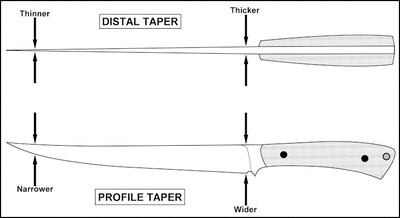
The design from the movies does not have a distal taper and I can guarantee no goblin would look at the abomination the movies called a sword and think it's remotely passable.
So, if we want to talk about what Godric Gryffindor's sword would actually look like?
It'll be something like this:
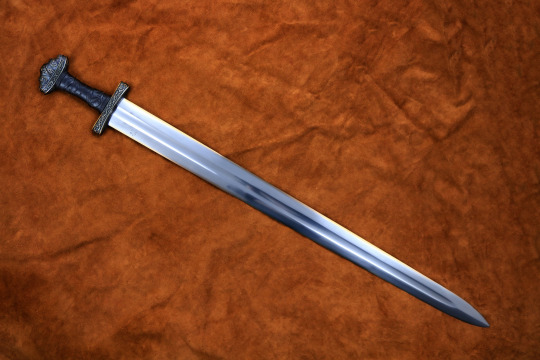
(11th-century Viking Sword, got popularised in Britain by the Viking invasions)
Or this:

(11th-century Anglo-Saxon Broadsword, existed in Britain since the 5th century in slightly different designs. Yes it is very similar to a Viking sword, it was a common design at the time)
Or even an arming sword that rose in popularity around the mid-11th-century:
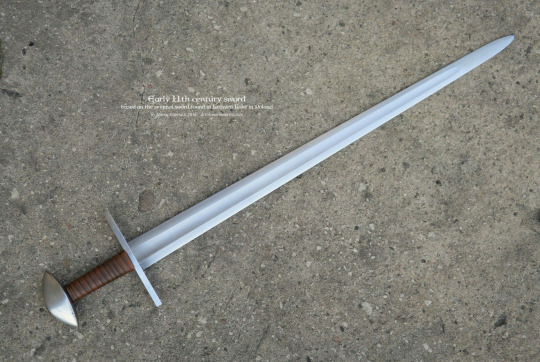
(Early 11th century English Arming Sword)
As an 11th-century English wizard, Godric could've had either of the three.
As for the design described in the book and how it could work with this kind of blade:
A gleaming silver sword had appeared inside the hat, its hilt glittering with rubies the size of eggs.
(CoS, 295)
For the metal, there are two possibilities here:
Harry doesn't know much about swords or metals, I think he could mistake polished steel for silver. Silver is way weaker than steel and depending on forging, another steel sword could cut through it. Pure silver would also not hold its form as much as steel, so a sword design like that of older bronze swords (another softer metal) could be better for it than what was typical for steel swords in the 11th century. Even if the silver is hardened to keep it in shape (which can be done) it would become brittle and break easily. Basically, regular silver is a really bad metal for these kinds of swords, especially if your opponents wield steel. Which brings me to the second option...
The other possibility is that Goblin-forged silver is just magically very strong so it won't break under pressure (like regular hardened silver). Steel swords solve the issue by having some yield to bend instead of snapping, if goblin silver is just magically strong enough that the sword won't snap or the sword is enchanted unbreakable, this would work too.
As for the egg-sized rubies, well, maybe the size of fish eggs? I honestly don't know what JKR was on about here... The sword could have one egg-sized ruby on the pommel (the metal piece at the end of the hilt), but that's it.
If I were to get more specific with the design, I did like that the movies wrote Godric's name on the sword, which is very much possible with a more historically accurate functional sword. Like these Viking/Anglo-Saxon swords from the early 10th century with gold and silver inlay on the blade and hilt (The sword is damaged but it's real):
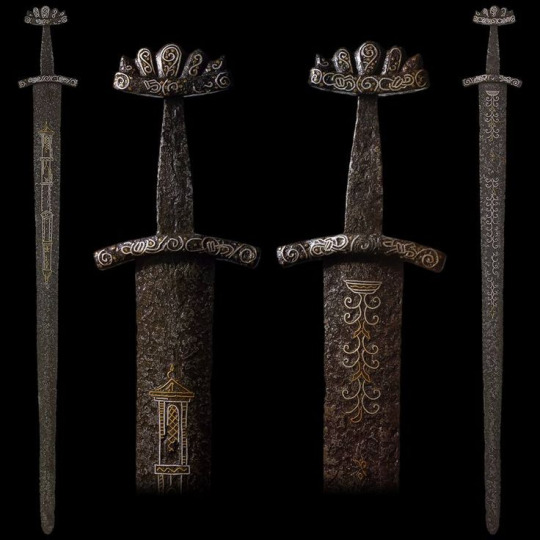
So his name and maybe some other patterns could be written on the sword in silver and gold, which would look really cool, in my opinion.
Also, you could get even decorative on the pommel and crossguard while keeping it functional, including the addition of more precious metals like silver beyond just inlaying it.
Like this replica of 10th-century bronze Viking sword hilt:

Ceremonial swords (not meant for battle) could get even more ornate on the hilt. Like the Essen Sword gifted in 993 A.D that actually has precious stones decorating its pommel and crossguard:
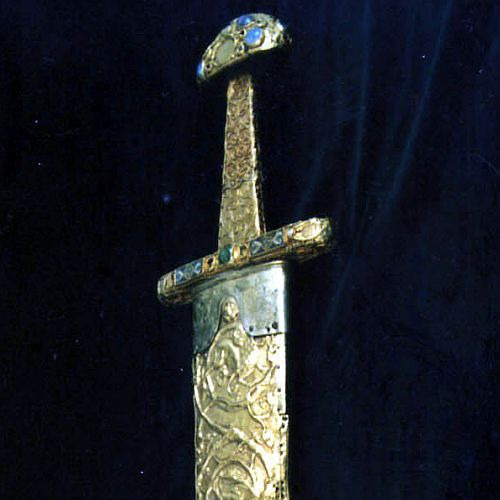
My vision for Gryffindor's sword
Steel blade or magical goblin-forged silver (doesn't really matter) that is shaped like the blades above. Personally, I'm leaning towards an arming sword design, with blade inlays of silver and gold that write the name Gryffindor along with some other magical imagery of lions or dragons.
The hilt would be made of silver (or covered in silver) and have one large ruby on the pommel and/or multiple rubies like in the sword pictured above along with gold inlays. I also imagine the crossguard ending with little lion heads, kinda like the little dragons on this crossguard (The date on this sword is debated to be anywhere between the 8th century to the 13th century, but they could create hilts like this in the 11th century):
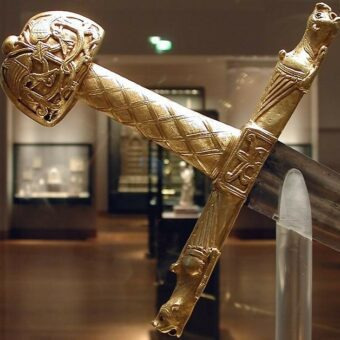
The hilt would have a wrap of leather so there would be a better grip for fighting. No way is Gryffindor carrying a ceremonial sword that he can't use. I think said leather should be painted red.
#harry potter#hp#harry potter thoughts#hp thoughts#rant#i guess#hollowedheadcanon#godric gryffindor#gryffindor's sword#hp films#hp headcanon
132 notes
·
View notes